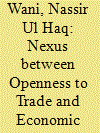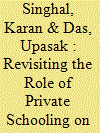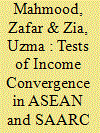|
|
|
Sort Order |
|
|
|
Items / Page
|
|
|
|
|
|
|
| Srl | Item |
| 1 |
ID:
168503


|
|
|
|
|
| Summary/Abstract |
The objective of this study is to investigate the presence of ‘club convergence’ in respect of income among 15 major states in India during 1982–2014 using Markov chain along with stochastic kernel. The distributional dynamics observed among the major states support the process of ‘club convergence’. The empirical findings prove the hypotheses that economies that are similar in their structural characteristics and initial per capita income levels will converge with each other in per capita terms in the long run. The present study empirically re-establishes the hypotheses of ‘low-level equilibrium trap’ caused by low human capital investment.
|
|
|
|
|
|
|
|
|
|
|
|
|
|
|
|
| 2 |
ID:
168505


|
|
|
|
|
| Summary/Abstract |
The article examines the various dimensions and underlying causes of informal employment in the Bangladesh labour market and the associated wage penalty. Based on labour force survey data for successive points, we trace the dynamics of employment in Bangladesh along the informal–formal divide over time. Given that wage differential remains a key feature concerning the two market segments, we have carried out mean and quantile decomposition exercises to estimate the wage penalty originating from informality. We find significant wage gaps between formal- and informal-paid employees, formal paid and informal day labour, and formal paid and informal self-employed. The wage gaps range between 65.0 per cent and 225.0 per cent. The gap arises from a combination of observed differences in human capital and job characteristics, and the wage premium accruing from formal employment.
|
|
|
|
|
|
|
|
|
|
|
|
|
|
|
|
| 3 |
ID:
168504


|
|
|
|
|
| Summary/Abstract |
The notion that the international trade is the foundation of economic growth dates long back, and even now, an irresistible body of literature confirms a strong and positive link between trade openness and economic growth. However, most of these studies are focused on developed countries. Indeed literature from developing countries are scant, those from under developed and a landlocked country like Afghanistan are almost non-existent. This article endeavours to innovatively scrutinize the relationship between trade liberalization and economic growth in Afghanistan, using biannual data for the period 1995–2016 and thus evaluates the comparative effect of three different measures of trade openness on the economic growth by using more rigorous econometric techniques. Autoregressive distributed lag (ARDL) method, JJ CO-integration and ordinary least square (OLS) results suggest significant positive long-run relationship between export and economic growth. In contrast, total volume of trade and imports have significant negative effect on the economic growth. The addition of variables and results of fully modified OLS suggest that the results are robust. The Granger causality and variance decomposition analysis indicate the unidirectional causality between trade openness and economic growth. In export model, causality runs from export to growth. Whereas, in the model with total volume of trade and import, causality runs from growth to total volume of trade and imports in Afghanistan. From the findings, it is concluded that the policymakers should focus on export promotion strategy to enhance the economic growth in Afghanistan. Besides, efficient utilization of capital goods should be ensured and reliance on non-capital goods should be less in order to ensure high domestic production in the country.
|
|
|
|
|
|
|
|
|
|
|
|
|
|
|
|
| 4 |
ID:
168507


|
|
|
|
|
| Summary/Abstract |
In the view of increasing preference of private schooling in India, this article assesses its impact on learning outcomes for rural children from 8 to 11 years. Despite earlier attempts to study the issue, this article stands out in two ways. Firstly, it addresses the problems arising because of non-random selection of children attending private schools. Secondly, it also presents an all-India estimate unlike most studies which have dealt largely with few states. Our results show the performance of children attending private school to be significantly better than those from public schools. This difference is evident among ‘low-fee’ private schools as well. However the private schooling premium differ across regions and groups, and there are several other concerns regarding affordability, access and segregation which require further deliberation and debate.
|
|
|
|
|
|
|
|
|
|
|
|
|
|
|
|
| 5 |
ID:
168508


|
|
|
|
|
| Summary/Abstract |
Over the years, researches have witnessed incongruence nature and direction of relationship among product market competition and firm size with the growth of firms’ productivity across the globe. Considering these gaps, this study aims to establish both short- and long-run relationships among these three characteristics of Indian manufacturing firms and intends to find their directions of causalities. This study uses firm-level data over a period of 1998–1999 to 2012–2013. Using Panel ARDL-PMG method, the results reveal the existence of a long-run association among product market competition, firm size and productivity growth for the full sample and for subsamples, categorizing relatively efficient and inefficient firms, and innovative and non-innovative firms. From the panel VECM Granger causality test, it has been observed that there is the long-run feedback relationship among these three variables. The empirical evidence suggests that as the intensity of competition becomes stronger and the firm-specific capabilities expand, they impart improved productivity via within and between firm effects. This draws some major implications for policymakers to embrace more competitive prone policies along with encouragement to firm specificities to realise value-added productivity.
|
|
|
|
|
|
|
|
|
|
|
|
|
|
|
|
| 6 |
ID:
168502


|
|
|
|
|
| Summary/Abstract |
The cherished goal of speedy economic growth in the Asian regional blocs cannot be achieved without attaining income convergence among them. Economic integration and assessment of income convergence or disparities among Asian blocs is the aim of this study. This study assesses a number of factors, such as trade openness, foreign direct investment, intellectual property rights protection and governance, to see how open economies are integrating themselves while competing with each other. Findings reveal that the SAARC group has not shown intra-regional income convergence, while the ASEAN group provides sufficient evidence. Although simultaneously considering SAARC and ASEAN groups in the form of a panel, there is evidence of non-convergence between the two regional groups. An important policy implication of the study is that the ASEAN and SAARC blocs are in dire need for combined and collective policy framework at the regional level.
|
|
|
|
|
|
|
|
|
|
|
|
|
|
|
|
| 7 |
ID:
168506


|
|
|
|
|
| Summary/Abstract |
This article examines the relationship between tourism and foreign direct investment (FDI) and the factors that enhance tourism in Sri Lanka using data over the years 1978–2015, under a vector autoregressive framework. The results reveal that there is a significant long-run equilibrium relationship between tourism, and a number of variables such as FDI, exchange rate, tourism price and civil war of the country. The results also reveal that there exist unidirectional causal relationships from FDI to tourism and tourism price to tourism, in both the long run and the short run. In light of this finding, it is recommended that Sri Lanka should introduce policies that would increase FDI inflows into the tourism industry and maintain a competitive tourism price to attract more tourist arrivals.
|
|
|
|
|
|
|
|
|
|
|
|
|
|
|
|
|
|
|
|
|